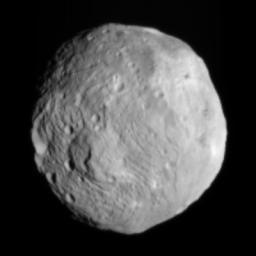
|
All Eyes on Vesta
- Click the image above for a larger view
- Full-Res JPEG (400 x 400) (11.3 kB)
- Full-Res TIFF (400 x 400) (160.4 kB)
Caption:
NASA's Dawn spacecraft obtained this image of the giant asteroid Vesta with its framing camera on July 9, 2011. It was taken from a distance of about 26,000 miles (41,000 kilometers) away from Vesta, which is alsoconsidered a protoplanet because it is a large body that almost became a planet. Each pixel in the image corresponds to roughly 2.4 miles (3.8 kilometers).
Background Info:
The Dawn mission to Vesta and Ceres is managed by the Jet Propulsion Laboratory, for NASA's Science Mission Directorate, Washington, D.C. It is a project of the Discovery Program managed by NASA's Marshall Space Flight Center, Huntsville, Ala. UCLA, is responsible for overall Dawn mission science. Orbital Sciences Corporation of Dulles, Va., designed and built the Dawn spacecraft.
The framing cameras have been developed and built under the leadership of the Max Planck Institute for Solar System Research, Katlenburg-Lindau, Germany, with significant contributions by the German Aerospace Center (DLR) Institute of Planetary Research, Berlin, and in coordination with the Institute of Computer and Communication Network Engineering, Braunschweig. The framing camera project is funded by NASA, the Max Planck Society and DLR. JPL is a division of the California Institute of Technology, in Pasadena. More information about Dawn is online at http://www.nasa.gov/dawn and http://dawn.jpl.nasa.gov .
Cataloging Keywords:
| Name | Value | Additional Values |
|---|---|---|
| Target | 4 Vesta | |
| System | Main Belt | |
| Target Type | Asteroid | |
| Mission | Dawn | |
| Instrument Host | Dawn | |
| Host Type | Orbiter | |
| Instrument | Framing Camera (FC) | |
| Detector | ||
| Extra Keywords | Grayscale | |
| Acquisition Date | ||
| Release Date | 2011-07-14 | |
| Date in Caption | 2011-07-09 | |
| Image Credit | NASA/JPL-Caltech/UCLA/MPS/DLR/IDA | |
| Source | photojournal.jpl.nasa.gov/catalog/PIA14312 | |
| Identifier | PIA14312 | |
